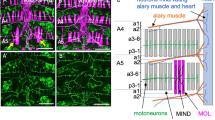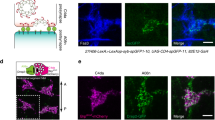Abstract
IN the Drosophila embryo, motor neurons form stereotyped synapses (neuromuscular junctions) on identified muscles1–3. We have used a mutant (prospero) that removes or delays innervation4,5 to assay the role of the presynaptic motor neuron in the development of the receptive field of the postsynaptic muscle, prospero (pros) is not expressed in the muscles or their precursors. Here we find that the muscle defines the correct synaptic zone in the absence of the motor neuron by restricting putative guidance molecules to this specialized membrane region. Furthermore, the muscle expresses functional transmitter receptors at the correct developmental time without innervation. On the other hand, the muscle does not localize receptors to the synapse without instruction from the motor neuron, nor does a second, much larger, synthesis of receptors occur in muscles deprived of innervation. In muscles receiving delayed innervation, or muscles innervated at aberrant synaptic sites, both receptor clustering and receptor synthesis are delayed or redirected, consistent with the new pattern of innervation. We conclude that the muscle autonomously defines the synaptic site, whereas the motor neuron directs the development of the muscle's receptive field by stimulating the synthesis and localization of transmitter receptors.
This is a preview of subscription content, access via your institution
Access options
Subscribe to this journal
Receive 51 print issues and online access
$199.00 per year
only $3.90 per issue
Buy this article
- Purchase on Springer Link
- Instant access to full article PDF
Prices may be subject to local taxes which are calculated during checkout
Similar content being viewed by others
References
Johansen, J., Halpern, M. & Keshishian, H. J. Neurosci. 9, 4318–4332 (1989).
Sink, H. & Whitington, P. J. Neurobiol. 22, 298–311 (1991).
Broadie, K. & Bate, M. J. Neurosci. 13, 144–166 (1993).
Doe, C., Chu-LaGraff, Q., Wright, D. & Scott, M. Cell 65, 451–464 (1991).
Vaessin, H. et al. Cell 67, 941–953 (1991).
Halpern, M., Chiba, A., Johansen, J. & Keshishian, H. J. Neurosci. 11, 3227–3238 (1991).
Nose, A., Mahajan, V. & Goodman, C. Cell 70, 553–567 (1992).
Liu, D. & Westerfield, M. J. Neurosci. 12, 1859–1866 (1992).
Dahm, L. & Landmesser, L. J. Neurosci. 11, 238–255 (1991).
Landmesser, L., Dahm, L., Taug, J. & Rutishauser, U. Neuron 4, 655–667 (1990).
Tosney, K., Watanabe, M., Landmesser, L. & Rutishauser, U. Devi Biol. 114, 427–452 (1988).
Anderson, M. & Cohen, M. J. Physlol., Lond. 268, 757–773 (1977).
Dennis, M. A. Rev. Neurosci. 4, 43–68 (1981).
Schuetze, S. & Role, L. A. Rev. Neurosci. 10, 403–457 (1987).
Sanes, J. et al. Development 113, 1181–1191 (1991).
Martinou, J.-C. & Merlie, J. J. neurosci. 11, 1291–1299 (1991).
Simon, A., Hoppe, P. & Burden, S. Development 114, 545–553 (1992).
Nitkin, R. et al. J. Cell Biol. 105, 2471–2478 (1987).
Reist, N., Werle, M. & McMahon, U. Neuron 8, 865–868 (1992).
Campanelli, J., Hoch, W., Rupp, F., Kreiner, T. & Scheller, R. Cell 67, 909–916 (1991).
Campos-Ortega, J. & Haenlin, M. Roux's Arch. Dev. Biol. 201, 1–11 (1992).
Hortsch, M. & Goodman, C. A. Rev. Cell Biol. 7, 505–557 (1991).
Jan, L., Jan, Y. & Hughs, H. Cell 69, 715–718 (1992).
Salkoff, L. et al. Trends neurosci. 15, 161–166 (1992).
Jan, L. & Jan, Y. Proc. natn. Acad. Sci. U.S.A. 72, 2700–2704 (1982).
Author information
Authors and Affiliations
Rights and permissions
About this article
Cite this article
Broadie, K., Bate, M. Innervation directs receptor synthesis and localization in Drosophila embryo synaptogenesis. Nature 361, 350–353 (1993). https://doi.org/10.1038/361350a0
Received:
Accepted:
Issue Date:
DOI: https://doi.org/10.1038/361350a0
This article is cited by
-
WNTs tune up the neuromuscular junction
Nature Reviews Neuroscience (2009)
-
Glutamatergic synapses of Drosophila neuromuscular junctions: a high-resolution model for the analysis of experience-dependent potentiation
Cell and Tissue Research (2006)
-
Increased synaptic microtubules and altered synapse development in Drosophila sec8 mutants
BMC Biology (2005)
-
Developmental regulation of glutamate receptor field size by nonvesicular glutamate release
Nature Neuroscience (2002)
-
Longitudinal body wall muscles are electrically coupled across the segmental boundary in the third instar larva ofDrosophila melanogaster
Invertebrate Neuroscience (1996)
Comments
By submitting a comment you agree to abide by our Terms and Community Guidelines. If you find something abusive or that does not comply with our terms or guidelines please flag it as inappropriate.



